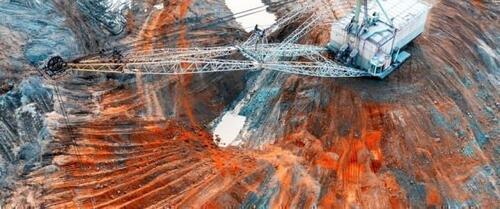Geopolitical Tensions Are Transforming The Rare Earth Market
Authored by Rystad Energy via Oilprice.com,
China’s dominance in the rare earth market is gradually declining as other countries ramp up production.
Western governments are incentivizing domestic rare earth production to reduce reliance on China and mitigate supply chain risks.
Despite recent price volatility and oversupply, rare earth demand is expected to remain strong due to their essential role in high-tech and green technologies.
The rare earth market is undergoing a shift in geographical supply chain concentration, spurred by Western efforts to reduce reliance on China off the back of growing demand, focus on national security, and the strategic importance of the materials. Over the last decade, annual rare earth supply has tripled, setting global production records almost every year – from 142,000 tonnes in 2013 to 359,000 tonnes of rare earth oxide equivalents mined last year.
The rare earths market is in a state of flux, finding itself at the crossroads of technological innovation and geopolitical tension. China’s long-standing dominance remains strong but is gradually waning with its share of global production declining from 98% in 2010 to 78% in 2015 and down to 67% last year as producers in Australia and the US, backed by substantial government support, ramp up activity.
China is still dominant, although its market share is declining
Despite a decline in China’s market share in the upstream mining sector, its absolute supply output is still rising. More importantly, its control across the complex midstream to downstream processing and manufacturing stages is proving harder to shake. Although relatively geologically abundant, rare earths are deemed rare because extracting and separating the ores into individual oxides needed for use in manufacturing is difficult. This makes economically viable deposits rare. The consolidated state-controlled Chinese market is at the forefront of industrial and technologically demanding operations related to rare earths processing. Last December, China imposed export control of technologies for rare earth extraction, separation, refining and magnet production, potentially slowing down new development outside of the country. Continued financial backing will be required from Western governments to loosen China’s mature grip and increase its market share across the rare earth processing value chain.
Regional policies to boost domestic rare earths supply
The US is promoting the development of its domestic rare earths value chain through research funding and project financing via the Inflation Reduction Act. Australia has long supported rare earths projects through tax incentives, meanwhile, Europe aims to build out supply through domestic targets for supply quotas through its Critical Raw Materials Act. In May this year, both the US and Australia announced policies to combat competition from China. Australia announced the extension of incentives in the 2024-2025 budget plan through a 10% production tax credit and pre-feasibility project funding for all critical minerals, including rare earths. At the same time, the Biden administration in the US imposed a 25% import tariff on rare earth magnets from China, effective from 2026.
There are several countries with abundant rare earth ore reserves, and with global reserves measuring around 115 million tonnes, the world has enough to last over 300 years, based on last year’s production volumes. With more reserves likely to be discovered, a shortage of resources is not a realistic concern.
Although small in volume compared to the over 3 billion tonnes of metals mined annually, rare earth elements are crucial to society, and their unique properties have proven extremely difficult to substitute. Demand for the 17 lustrous silvery-white metals has risen recently due to their essential role in buoyant energy transition-related sectors, as well as in high-tech equipment within defense, artificial intelligence and consumer electronics. Permanent magnets, required for any device related to electric motion such as wind turbines and electric vehicle (EV) motors, is the largest application for rare earths, making the magnetic rare earths neodymium, praseodymium, dysprosium and samarium among the most in-demand and highly valued rare earths. We expect the magnetic rare earths to remain principal, propelled by technological advancements and the electrification of society.
The race between China and the West will continue
A dramatic rise in supply has outpaced demand over the last few years, resulting in an oversupply of rare earth products. This has created an erratic low-price environment where many producers are operating at a loss. Rare earth prices are notoriously volatile and difficult to predict, partly due to their high susceptibility to geopolitical risk and ongoing global trade disputes. A volatile price environment is challenging early-stage initiatives launched by an expanding supplier landscape aiming to capitalize on the emerging globalized supply chain.
Rare earths have become a key battleground in the ongoing technological and economic rivalry between China and the West as the race continues for control to ensure its reliable supply.
Tyler Durden
Tue, 08/13/2024 – 19:15

